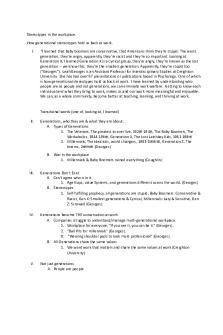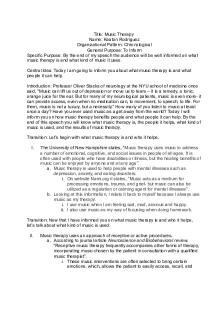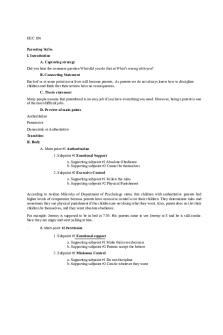COMM1101Issues Informative Speech PDF

| Title | COMM1101Issues Informative Speech |
|---|---|
| Course | Introduction To Public Speaking |
| Institution | University of Minnesota, Twin Cities |
| Pages | 4 |
| File Size | 60 KB |
| File Type | |
| Total Downloads | 74 |
| Total Views | 124 |
Summary
Informative Speech Example...
Description
Jordan Mendkoff COMM 1101 3/12/14 Issues Informative Speech In 2013, Johnny Manziel became the first ever freshman to win the Heisman trophy, the award given annually to the top college football player in the nation. What most people don’t know, is that according to a press release by the Texas A&M athletic department, Manziel winning this award generated roughly $37 million dollars in media exposure for the university. As an avid college sports fan myself, it can easily be seen that the popularity of college sports, especially basketball and football, has been growing at a rapid rate. As this popularity has been growing larger, the issue of paying college athletes has been on the rise as well. This issue, also called pay for play, is an issue that has been gaining serious traction as of late. Today I am going to talk to you about the importance of the pay for play debate, instances of this debate in the news, counterarguments from its opposition, and some possible solutions to the issue. The issue of pay for play has long been present in the realm of college athletics. With collegiate sports generating the huge amount of money for universities that it does, the argument has formed that the athletes who help generate that income should be able to reap its benefit as well. In a recent article by Business Insider, the Fair Market value was calculated for each of the 25 most profitable college football programs. This was done using the NFL’s most recent collective bargaining agreement in which the players receive a minimum of 47% of all revenue, and dividing this by the 85 scholarship players on their rosters. Using this method, it was estimated that the average college football player at the University of Texas is worth $578,000 per year. It was also found that the University of Texas spends roughly $3.2 million on scholarships for football players on average, which amounts to around $37,600 per player. That is a huge difference. This is an example of what is going on at schools with major athletic programs across the country. According to NCAA Regulations, an athlete is not eligible for participation in a sport if
Jordan Mendkoff COMM 1101 3/12/14 Issues Informative Speech they have ever taken pay, or the promise of pay, for competing in that sport or used their athletic skill for pay in any form in that sport. It also states than an athlete is not eligible in a sport if they have ever have accepted money, transportation or other benefits from an agent or agreed to have an agent market their athletics ability or reputation in that sport. In the history of college athletics, there have been a few notable instances in which these NCAA regulations have been broken. According to Time, The NCAA hit Ohio State with a one-year bowl ban and other penalties in December of 2011 for a scandal that involved eight players taking a total of $14,000 in cash and tattoos in exchange for jerseys, rings and other Buckeyes memorabilia. This scandal also lead to the resignation of their head coach Jim Tressel, as well as the ineligibility of the players involved, including most notably star quarterback Terrelle Pryor. According to Sports Illustrated, an investigation of the University of Michigan Basketball team lead to the discovery that booster Ed Martin provided $616,000 to Chris Webber and several other players on the team during their time at Michigan. This lead to their head coach Steve Fisher being fired, and the Wolverines were placed on a two-year probation period as well as being forced to surrender its 1992 and 1993 Final Fours. The Los Angeles Times states that former UCLA basketball star Ed O'Bannon is the lead plaintiff in a lawsuit alleging former college football and basketball players are illegally denied a share of profits made by the NCAA through the sale of television and online reruns, video games, jerseys and other paraphernalia. An issue that often comes up in the pay for play debate is affordability. According to ESPN, in 219 Division I schools, subsidies to athletic departments from student fees and general university funds have increased on average over the last five years, not decreased. For hundreds
Jordan Mendkoff COMM 1101 3/12/14 Issues Informative Speech of schools already struggling to balance budgets, paying athletes would seemingly lead to financial ruin. Adding in the specter of worker's compensation to cover injuries and other potential new realities associated with turning students into employees would cause additional financial hardship as well. While most people address this debate and discuss the sports that generate the most income for universities such as men’s basketball and football, according to ESPN consideration would have to be given to Title IX, which has been the driving force for equality in athletics for women for over 40 years. Only paying male college athletes in revenue sports would be a clear violation of Title IX. Since Title IX is a federal law, many think that trying to mess with it would be a risky strategy to take. Some opponents to pay for play insist that paying college athletes would widen the gap between the top athletic programs and the less prominent ones. Some fear that pay for play could cause the football playing programs in the power conferences to separate from the NCAA as a whole and form their own governing body. According to ESPN some possible solutions to solve this issue that have been discussed include full-cost scholarships, giving players stipends, compensating star athletes, and paying players in the sports that generate revenue for the school. Each of these solutions are being considered as possible methods to solve the pay for play issue. In conclusion, I have told you about the importance of the pay for play debate, instances of this debate in the news, counterarguments from its opposition, and some possible solutions to the issue. With college sports popularity and notoriety on the rise, pay for play is a key issue that will need to be addressed that will shape the future of college sports as we know it.
Jordan Mendkoff COMM 1101 3/12/14 Issues Informative Speech
References: ● http://sports.espn.go.com/ncaa/columns/story?columnist=forde_pat&id=6746255 ● http://www.aggieathletics.com/ViewArticle.dbml?ATCLID=206020080 ● http://espn.go.com/college-sports/story/_/id/6768411/pay-play-proposals-ncaa-studentathletes ● http://www.businessinsider.com/chart-the-average-university-of-texas-football-player-isworth-578000-2013-9 ● http://fs.ncaa.org/Docs/AMA/compliance_forms/DI/DI%20Summary%20of%20NCAA %20Regulations.pdf ● http://newsfeed.time.com/2011/12/20/ohio-state-hit-with-one-year-bowl-ban-overbribery-scandal/ ● http://sportsillustrated.cnn.com/multimedia/photo_gallery/1108/top-scandals-ncaahistory/content.14.html ● http://articles.latimes.com/2009/jul/22/sports/sp-videogames-lawsuit22...
Similar Free PDFs

Informative speech
- 4 Pages

Informative Speech
- 3 Pages

Informative speech
- 3 Pages

Informative Speech
- 3 Pages

Informative Speech
- 3 Pages

INFORMATIVE SPEECH
- 6 Pages

Informative Speech
- 3 Pages

Informative Speech
- 8 Pages

Informative Speech
- 5 Pages

Informative speech
- 4 Pages

Informative Speech
- 2 Pages

Informative Speech Outline
- 5 Pages

Informative Speech Rubric
- 3 Pages
Popular Institutions
- Tinajero National High School - Annex
- Politeknik Caltex Riau
- Yokohama City University
- SGT University
- University of Al-Qadisiyah
- Divine Word College of Vigan
- Techniek College Rotterdam
- Universidade de Santiago
- Universiti Teknologi MARA Cawangan Johor Kampus Pasir Gudang
- Poltekkes Kemenkes Yogyakarta
- Baguio City National High School
- Colegio san marcos
- preparatoria uno
- Centro de Bachillerato Tecnológico Industrial y de Servicios No. 107
- Dalian Maritime University
- Quang Trung Secondary School
- Colegio Tecnológico en Informática
- Corporación Regional de Educación Superior
- Grupo CEDVA
- Dar Al Uloom University
- Centro de Estudios Preuniversitarios de la Universidad Nacional de Ingeniería
- 上智大学
- Aakash International School, Nuna Majara
- San Felipe Neri Catholic School
- Kang Chiao International School - New Taipei City
- Misamis Occidental National High School
- Institución Educativa Escuela Normal Juan Ladrilleros
- Kolehiyo ng Pantukan
- Batanes State College
- Instituto Continental
- Sekolah Menengah Kejuruan Kesehatan Kaltara (Tarakan)
- Colegio de La Inmaculada Concepcion - Cebu


